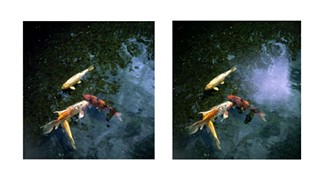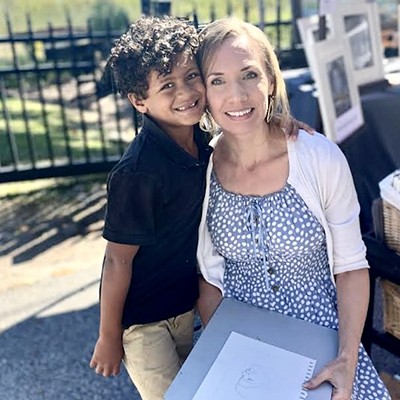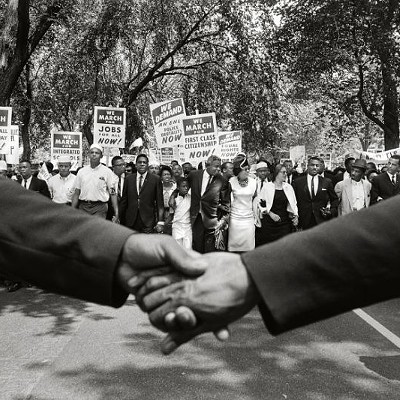IF YOU want something done right, do it yourself, and the four women of "LOOK" did just that.
Jemma Castiglione and Eva Verbeeck began the group by getting together at Castiglione’s house to talk about their photography work.
“We’d wanted to get a group of women photographers together for a while,” says Castiglione, “just as a way to talk about photo work and especially to do critiques, because that’s something we all feel like we lack, especially in a classroom setting.”
“Within the other students, there was never any engaging,” adds Rachel Treide. “I could count on some professors I had to be able to talk to, they’d have a lot to say, but a lot of times other students were a bit lacking in overall engagement.”
“It just seems like everyone’s in their own little world,” joins Kendra Stanziola-Mirrop.
So Verbeeck, Castiglione, Treide, and Stanziola-Mirrop got together consistently each week to talk about their work and fill the void they saw in their SCAD photography classes.
“There was no community or space, and we all have this common passion that we love and practice really diligently,” says Treide. “So to have friends that are intentional to set aside time and say, ‘Hey, we’re doing breakfast at 8 a.m., be there’—”
“It was not 8 a.m.!” laughs Castiglione.
It’s easy to tell that the breakfast meetings helped the women be able to talk about not only their work, but each other’s. When I met with Castiglione, Stanziola-Mirrop, and Treide, they were all well-versed in each other’s work as well as Verbeeck’s, who was in Belgium. All four women are strong conceptual photographers, but each has a different style.
Treide’s degree is in art history, so her approach to “LOOK” is more process-oriented. She became interested in stereography while writing her thesis on photographer Stephen Shore.
“He worked with stereography, which are 3D images, in 1974 for like two months,” recalls Treide. “I started using the camera so I could better understand that process, and that just opened up a new area of my own work.”
At “LOOK,” Treide will display stereoscopes to view the work she’s made.
As the resident art historian of the group, Treide also wrote about each of the other artists’ work.
During her time in Savannah, Stanziola-Mirrop has borne witness to a lot of gun violence.
“It happens all over the place in Savannah,” she says. “First, it was just getting accustomed to gun violence and seeing it every day. But I recently moved in with a mom with a seven year-old biracial child. I’ve had black friends, I know that experience, but it’s different seeing it from a mother’s perspective.”
Stanziola-Mirrop visits sites of gun violence during different times of day, sometimes making up to 40 different visits, and photographs the scene with a large-format camera.
“You can almost place yourself in that picture,” says Treide.
Castiglione’s work is focused on capturing portraits of her family members after going through some difficult family trauma.
“My dad is very masculine and dominant, and he uses religion as a reason to do it,” she explains. “I’m trying to normalize the pain my family has gone through, the emotional abuse they went through. Not a lot of people even know to term it like that. We didn’t term it like that until after the majority of the stuff happened.”
Back home in Alabama, Castiglione’s family has splintered.
“I’ve been the least affected by it, and because of that I’ve taken on the role of the mediator,” says Castiglione.
“She’s taken on the role of documenting her family, and it’s even more emotional, if I can speak to this,” adds Treide. “This project is a way to heal from that and to look at what has happened. This role of family photography becomes even more interesting in her work.”
Growing up in Belgium, Verbeeck learned about American culture through media.
“When she comes to America for the first time in 2015, it’s more or less accurate to what she’s seeing, but she discovered the people were not at all the people who had been portrayed,” says Treide. “Of course we don’t really portray real Americans because it’s ugly. It’s real. It’s showing women and girls that were not portrayed in American media, which I think is a normal enough endeavor, but hers is so interesting because she is from Belgium. We as Americans can look at our own culture and document it, but sometimes it takes an outsider. The longer you live somewhere, the less you see things.”
Verbeeck’s photographs capture teenage girls, particularly teenage girls or pageant queens.
All four of the bodies of work show a different take on the human experience.
“Photography allows you to interact with the world,” says Treide. “You’re breaking out of the confines of the traditional artistic studio. You have this mobility and the ability to engage with lived experience that no other medium has.



























